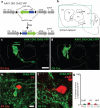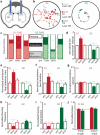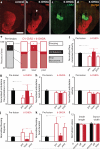Regulation of parkinsonian motor behaviours by optogenetic control of basal ganglia circuitry
- PMID: 20613723
- PMCID: PMC3552484
- DOI: 10.1038/nature09159
Regulation of parkinsonian motor behaviours by optogenetic control of basal ganglia circuitry
Abstract
Neural circuits of the basal ganglia are critical for motor planning and action selection. Two parallel basal ganglia pathways have been described, and have been proposed to exert opposing influences on motor function. According to this classical model, activation of the 'direct' pathway facilitates movement and activation of the 'indirect' pathway inhibits movement. However, more recent anatomical and functional evidence has called into question the validity of this hypothesis. Because this model has never been empirically tested, the specific function of these circuits in behaving animals remains unknown. Here we report direct activation of basal ganglia circuitry in vivo, using optogenetic control of direct- and indirect-pathway medium spiny projection neurons (MSNs), achieved through Cre-dependent viral expression of channelrhodopsin-2 in the striatum of bacterial artificial chromosome transgenic mice expressing Cre recombinase under control of regulatory elements for the dopamine D1 or D2 receptor. Bilateral excitation of indirect-pathway MSNs elicited a parkinsonian state, distinguished by increased freezing, bradykinesia and decreased locomotor initiations. In contrast, activation of direct-pathway MSNs reduced freezing and increased locomotion. In a mouse model of Parkinson's disease, direct-pathway activation completely rescued deficits in freezing, bradykinesia and locomotor initiation. Taken together, our findings establish a critical role for basal ganglia circuitry in the bidirectional regulation of motor behaviour and indicate that modulation of direct-pathway circuitry may represent an effective therapeutic strategy for ameliorating parkinsonian motor deficits.
Figures




References
-
- Yin HH, Knowlton BJ. The role of the basal ganglia in habit formation. Nat. Rev. 2006;7:464–476. - PubMed
-
- Hikosaka O, Takikawa Y, Kawagoe R. Role of the basal ganglia in the control of purposive saccadic eye movements. Physiol. Rev. 2000;80:953–978. - PubMed
-
- Graybiel AM, Aosaki T, Flaherty AW, Kimura M. The basal ganglia and adaptive motor control. Science. 1994;265:1826–1831. - PubMed
-
- Smith Y, Bevan MD, Shink E, Bolam JP. Microcircuitry of the direct and indirect pathways of the basal ganglia. Neuroscience. 1998;86:353–387. - PubMed
-
- Albin RL, Young AB, Penney JB. The functional anatomy of basal ganglia disorders. Trends Neurosci. 1989;12:366–375. - PubMed
Publication types
MeSH terms
Substances
Grants and funding
LinkOut - more resources
Full Text Sources
Other Literature Sources
Medical
Molecular Biology Databases

